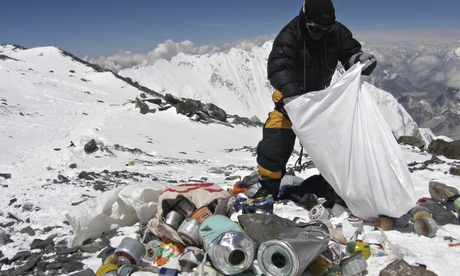Himalayan peaks could be leased to private tourism companies in an attempt to ease increasing congestion on Mount Everest, officials in Nepalhave said.
The proposal would involve hiring out some of the 326 Himalayan peaks that are currently open to climbers in the poor south Asian country, in an attempt to lure mountaineers away from Everest.
The highest mountain in the world is suffering from traffic jams and environmental degradation as hundreds of mountaineers attempt its ascent in a short window of favourable weather in late spring every year. Hundreds of other peaks, many unclimbed, receive no attention.
The move is also designed to attract more climbers to the impoverished country, which depends on the revenue from tourism.
"We have begun discussion on leasing unclimbed peaks to the private sector, to promote these mountains as new tourism products," said Mohan Krishna Sapkota, spokesman for the tourism ministry.
"We are open to both Nepalese and foreign private companies... We are confident that if the plan goes ahead, it will generate revenues for Nepal," Sapkota told Agence France-Presse.
The proposal would need to be passed by cabinet to get the green light. If agreed, it may take several months before it is implemented.
The Nepal Mountaineering Association (NMA), a national body representing tourism promoters, welcomed the proposal, which it said would be "a very good step".
"The private sectors can sell tourism products better in comparison to the government sector," said Ang Tshering Sherpa, the NMA's president.
"Private sector professionals have good networks worldwide and can bring more climbers and tourists to Nepal," Sherpa said.
In recent weeks, Nepal has introduced a raft of measures to boost tourism and also allay concerns of overcrowding on Mount Everest.
Officials have slashed mountaineering fees for many other peaks while requiring each climber scaling Everest to bring back 8kg (17.6 lbs) of garbage in an attempt to clean up the "roof of the world".
Last year, officials floated the idea of installing a ladder on the famous Hillary Step, a crucial stretch of technical climbing at nearly 8,840 metres (29,000ft) on Everest, named after its first climber, Sir Edmund Hillary.
Last year, more than 500 climbers reached the summit of Everest. On 19 May, around 150 climbed the last 915 metres to the peak within hours of each other, causing lengthy delays as mountaineers queued to descend or ascend harder sections.
Though such innovations as the ladder and the leasing plans are anathema to many purist climbers, some sherpas welcome them.
But Tashi Tenzing, grandson of the first climber to reach the summit of Everest, Tenzing Norgay, said the proposal went "completely against the spirit of mountaineering".
"Mountains are there to be climbed by anyone," he said. "It won't make any difference to the number of people who want to climb Everest."
An accomplished guide and mountaineer, Tenzing said he welcomed any move that would bring more climbers to lesser known peaks, and thus more funds to remote communities. But, he said, it would be better to promote such mountains overseas rather than lease them.



